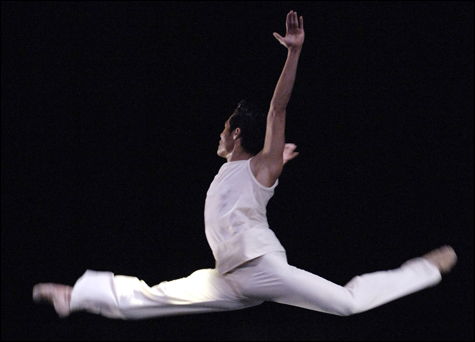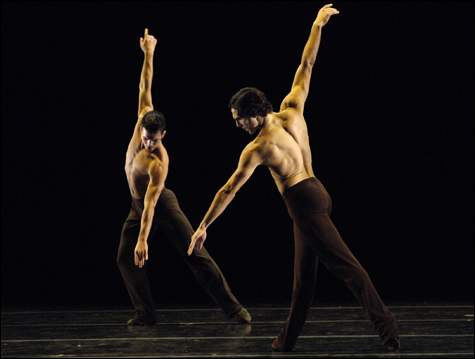
EIN VON VIEL: Taking us beyond gorgeous bodies doing dancedancedance. |
Boston Ballet artistic director Mikko Nissinen introduced the company’s “Next Generation” program Thursday night with a brief curtain speech celebrating the four choreographers whose works were being showcased. Incidentally Nissinen was staging himself, as an impresario of new talent. Jorma Elo, Helen Pickett, Sabrina Matthews, and Heather Myers were all spotted by Nissinen and recruited to spike the Boston repertory with contemporary ballets.
It was also Nissinen’s genial idea to put up Téssera, a little prologue piece for the choreographers, who weren’t dancing elsewhere on the program that evening. Directed by Elo to a tape-looped rhythmic fragment lifted from Sibelius, the four performed tiny solos establishing themselves as distinct dancing personalities, teaming in a couple of unison passages but maintaining their individuality.
The dances that followed all looked different but operated the same way in concept. Each one offered a banquet of ballet-powered movement superbly performed. Without characters or “argument” in the dramaturgical sense, they delivered dramatic encounters, erotic duets, and attention-grabbing stage effects. Each one used compelling music as a scaffolding on which to establish a mood or an energy. Only Sabrina Matthews’s ein von viel (“one out of many”), for a pair of men and an on-stage pianist, proposed that a work, even a modest one, could take us beyond gorgeous bodies doing dancedancedance.
With pianist Freda Locker on stage, playing selections from Bach’s Goldberg Variations, two men in white pants and tops began the dance side by side. You wouldn’t take them for well-matched partners — James Whiteside, tall and lanky, John Lam, dark and compact — but Matthews blended and contrasted them in a series of intricate movement inventions.
Their first canonic moves suggested the echo-and-consonance encounter of the two-man variation from George Balanchine’s Agon. But Matthews ventured deeper into compositional territory, as the dancers played off each other, copying moves but reversing them from left to right, displacing shapes or gestures to different parts of the body, plunging toward the floor instead of going into the air on a particular step. Each got a small solo, but the heart of the piece was their interlocking differences.

GONE AGAIN: Schubert’s lullaby/funeral march prompted no death forebodings or sexual anxiety. |
ein von viel (2001) was commissioned by Mikko Nissinen when he headed the Alberta Ballet and Matthews was dancing there. He’s given a similar opportunity to Alberta Ballet alumna Heather Myers, now a Boston Ballet second soloist. In Gone Again, with an ensemble from the Boston Ballet orchestra, three couples danced to the second movement of Franz Schubert’s String Quartet No. 14 in D minor (Death and the Maiden).Myers used a classical vocabulary pushed out of line here and there for expressionistic effects — tilting heads, thrusting upper torsos, off-balance leanings. Benjamin Phillips’s rustic rafters above the stage suggested some Bavarian folk tale in the background. The music’s reference is an ambiguous confrontation between a frightened young girl and a stranger who promises that if she comes away with him, she’ll sleep safely in his arms.